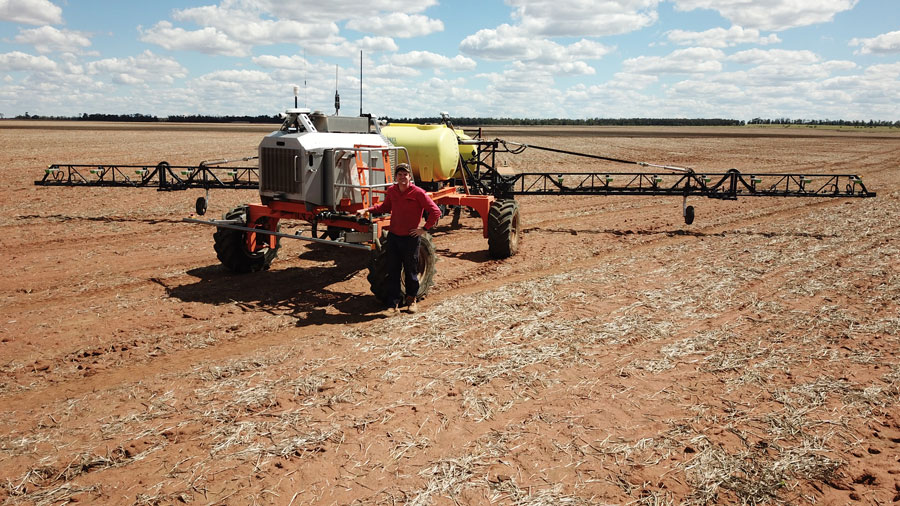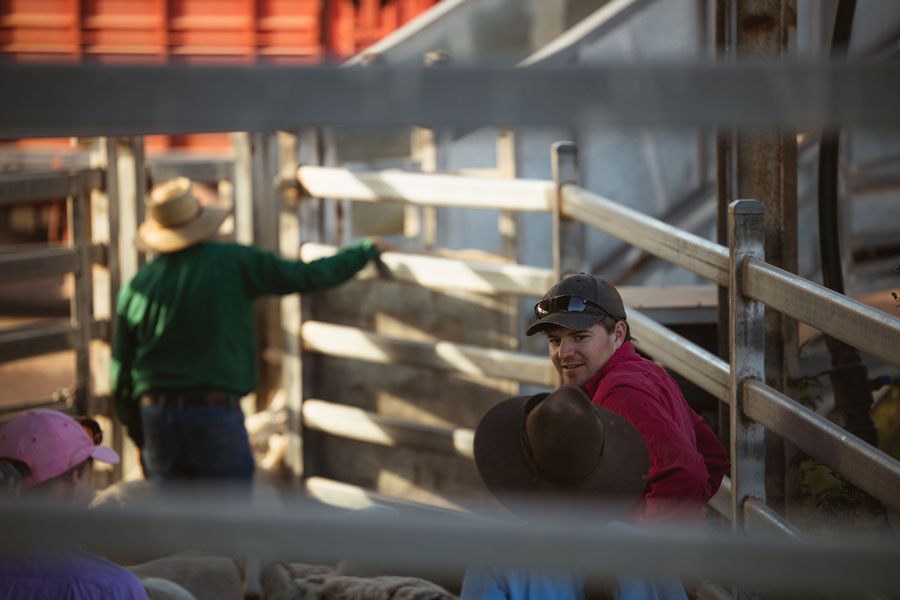Key points
- The Coggans took delivery of two SwarmFarm-operated WeedIts 18 months ago
- Tom Coggan took on the task of improving on-farm maps himself to learn more about how the system worked
- Already the robots have helped alleviate labour issues
In the middle of last year’s winter cereal harvest, Tom Coggan clocked up an 18-hour day on the header, not an unusual feat for grain growers during that busy period.
However, he was also operating two SwarmFarm-run WeedIts at the same time. Each of them worked an 18-hour day. It meant that in one 24-hour block, Tom and the two robots essentially did more than a week’s work.
Tom farms at Meandarra on Queensland’s Western Downs with his father Phillip, mother Cindy and sisters Emily and Sarah. He says that together he and the robots worked 54 hours that day. “That’s more than one person does in a week and that’s one of the benefits of the robots.”
The Coggans purchased the two 18-metre WeedIt booms with SwarmFarm robotics from Hayes Spraying in Goondiwindi about 18 months ago.
At the time they were considering a new 36-metre sprayer. “We had already received a quote about a new sprayer – a good piece of equipment – but then mum and dad attended a SwarmFarm field day. That day changed our thinking about camera sprayers and, as a result, we had an order for two SwarmFarm ‘bots’ before we made it home from the field day.”

Western Downs grower Tom Coggan’s new SwarmFarm-operated WeedIts have added an extra 36 metres of spraying to the enterprise without employing anyone. Photo: Tom Coggan
While greatly impressed by seeing the kit in action, the decision was also based on ongoing labour issues.
“At the time, we were facing a labour shortage, and since then it has actually gotten worse. We were thinking about logistics – how would we operate a second camera sprayer when we don’t have enough drivers to run the current one seven days a week?”
The new SwarmFarm-operated WeedIts have given the enterprise a solution. “We have been able to add an extra 36 metres of spraying to our mix and we haven’t had to employ anyone to do it.”
Tom says that, like the whole agricultural industry, his region is struggling with labour shortages. Automating some on-farm tasks helps to meet workload demands and lets more experienced staff do other jobs.
He adds that spot spraying can be a mind-numbing task after a while. “Humans like to be challenged. So, we can give that task to the robots and use our staff in other jobs.”
The robots run at eight to 9.5 kilometres an hour, 14 to 24 hours a day. So far, they have completed about 4000 hours and 26,000 hectares on the Coggans’ farm.
With only two public roads across the farm, they move freely between paddocks, folding themselves up after a job is done before moving on to the next one.
While Tom currently uses the robots for fallow spot spraying and in-crop fungicide spraying, he is keen to use them for planting in the future. Their success on the farm is also leading the family to consider other new technologies, with virtual fencing high on the list.
Tackling on-farm mapping
When two robots moved on to the Coggan family farm at Meandarra on Queensland’s Western Downs, one of Tom Coggan’s first jobs was to get mapping.
Mr Coggan, with his parents Phillip and Cindy and sisters Emily and Sarah, runs Coggan Farms, a 20,000-hectare cattle, lamb and grain enterprise.
Nearly 18 months ago they took delivery of two SwarmFarm-operated WeedIts. The boom sprays, supplied by Hayes Spraying in Goondiwindi, spot spray fallow weeds and spray in-crop fungicide.

Tom Coggan, pictured here loading sheep, credits SwarmFarm robots with helping to alleviate labour issues, key on a busy cattle, lamb and grain enterprise. Photo: Sacha Lorber
Tom’s decision to map was to ensure the robots ran successfully. “I would have said our mapping was reasonable but not perfect. Because we always had human operators on the spray rigs it didn’t matter necessarily how good the map was because you knew that a human would spray to the edge of the paddock.”
The robots, however, needed to know exact boundaries – that is the A-B lines or reference set for each field, plus obstacles and headlands.
Newly back to the farm after completing a Master of Agribusiness at the University of Queensland, Mr Coggan decided to undertake the mapping himself. “It wasn’t a problem. We had always wanted to do it but never had the actual economic imperative. Suddenly we did.
“I chose to map our paddocks myself so that I had control over how the maps worked and to learn more about how the software worked too.”
Doing it himself meant Mr Coggan would also be in a better position to fix things in the future and not rely on contractors. “If there was a huge washout in a paddock or something, I could change the maps.”
The weather over the past 18 months meant that melon holes did become full of water. “I had to sometimes remap a paddock that had melon holes in it so that the robot did not drive through them.”
Using a base station in tandem with the robot’s two global positioning systems (GPS), Mr Coggan drove the paddocks on his John Deere buggy, also with a GPS attached, filling in trees and other points the robots should avoid. He put that into SwarmFarm planning software to design a path for the sprayers. The farm model could then be uploaded on to the robots and begin being used.
Day-to-day operations
Mr Coggan oversees the robots on a day-to-day basis, estimating he spends five to 10 hours each week with them. This involves filling and refilling their tanks, making sure everything is working, and waving them off as they head out for the day.
The robots drive at eight to 9.5 kilometres an hour with the 18-metre boom. In a 24-hour period, they can spray 350 hectares each, day in and day out, depending on the weather.
“They are achieving a fair bit of country, as much as one human-driven machine. So, we’ve been able to add an extra 36 metres of spray boom on to our property without having to employ anyone else to do it.”
Cost-wise, the robots are about the same as a normal sprayer, but Mr Coggan says they are cost-efficient and effective.
“For example, the robot-sprayed paddocks are cleaner than the human-sprayed ones.
“That is because that is the robot’s job – whereas staff only work Monday to Friday and will often get called out to do another job, like fixing a fence. The robots don’t.”
They also help alleviate stress about staff and potential shortages. Instead, existing staff can be used elsewhere. Other benefits include lower chemical and fuel costs.
Leaps and bounds
Despite not having the robots very long, the Coggans have already noticed the technological change, with software updates occurring regularly.
SwarmFarm has about 50 robots operating, Mr Coggan says. “If one farmer finds an issue, they can update the whole fleet. So, it feels like you are not a pioneer in this new technology. You all get the fix if one is needed.
“The team at SwarmFarm do an incredible job with the machines operating very seamlessly. They continually bring updates to improve the product.” This has helped the Coggans get their heads around the idea of leasing the robots, not owning them.
“That was a challenge at the beginning. We were hesitant to hand them back in three years, but the technology is moving that fast. And you need to think about it like a computer. Would you buy one now thinking you’re going to keep it for 20 years? It’s the same thing.”
Future
Looking to the future, Mr Coggan would like to add more robots to the enterprise.
“I’d have two more if finances allowed. But, in saying that, we are running these two very efficiently and I would want that to
continue. In the future, I would be keen to have four robots – two running WeedIts full-time, another that is a full-time planter and one that flits between both jobs.
“It is a possibility that I’m starting to explore.”
More information: Tom Coggan, tom@cogganfarms.com.au; Hayes Spraying; SwarmFarm

























































